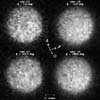| . |  |
. |
Dawn Deputy Principal Investigator Jet Propulsion Laboratory Pasadena - Mar 19, 2003 The Dawn mission officially started in September, 2002. During January, the mission team at JPL and Orbital Sciences Corp. reached full staffing levels and contracts for science team support were signed. The European team members at DLR (Berlin) and IFSI (Rome) have begun work on the framing cameras and mapping spectrometer, respectively. We are now sailing smoothly towards our Preliminary Mission and Systems Review in April, followed by the Preliminary Design Review (PDR) in August, 2003. The PDR is also the official mission confirmation review. Any successful journey requires careful route planning and efficient packing, and Dawn is no exception. Our journey will take us on a trip of 5. 5 billion kilometers over eight years, with major stopovers at Vesta and Ceres. Thus careful planning of the spacecraft trajectory is critical to mission success. The Dawn mission design and navigation team has been hard at work doing just that, and a report of their progress by Marc Rayman is featured in this newsletter. The mission team is now reviewing the availability, cost and performance of the payload and spacecraft systems and making sure everything fits within the mission's technical and cost resources. Thus far no technical obstacles have been identified, but we did have to abandon our plan to use a lightweight composite tank for the xenon propellant, and instead will carry a heavier but more reliable titanium tank with composite overwrap. The Dawn Science Team will be meeting in Houston, Texas on March 16 (in conjunction with the Lunar and Planetary Science Conference) and in Nice, France on April 5 (in conjunction with the joint European Geophysical Society / American Geophysical Union meeting), to verify the mission plans and requirements, and begin planning for the mission operations and data analysis. A paper describing the mission will appear in Planetary and Space Science later this year. Related Links Dawn Presentation: Asteroids, Comets and Meteors 2002 - PDF File Dawn at UCLA An Overview of Dawn SpaceDaily Search SpaceDaily Subscribe To SpaceDaily Express  Dulles - Jan 3, 2002
Dulles - Jan 3, 2002Orbital Sciences Corp has been selected to develop and build the first spacecraft designed to orbit main-belt asteroids for a total cost of $80 million excluding launch vehicle costs.
|
| ||||||||||
| The content herein, unless otherwise known to be public domain, are Copyright 1995-2016 - Space Media Network. All websites are published in Australia and are solely subject to Australian law and governed by Fair Use principals for news reporting and research purposes. AFP, UPI and IANS news wire stories are copyright Agence France-Presse, United Press International and Indo-Asia News Service. ESA news reports are copyright European Space Agency. All NASA sourced material is public domain. Additional copyrights may apply in whole or part to other bona fide parties. Advertising does not imply endorsement, agreement or approval of any opinions, statements or information provided by Space Media Network on any Web page published or hosted by Space Media Network. Privacy Statement All images and articles appearing on Space Media Network have been edited or digitally altered in some way. Any requests to remove copyright material will be acted upon in a timely and appropriate manner. Any attempt to extort money from Space Media Network will be ignored and reported to Australian Law Enforcement Agencies as a potential case of financial fraud involving the use of a telephonic carriage device or postal service. |